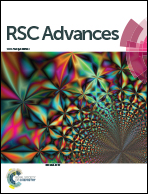An investigation into the solar light-driven enhanced photocatalytic properties of a graphene oxide–SnO2–TiO2 ternary nanocomposite†
Abstract
A novel graphene oxide (GO)–SnO2–TiO2-based ternary nanocomposite was prepared via a one-step solvothermal process. The structure, morphology, and optical properties were characterized by a series of techniques, including X-Ray Diffraction (XRD), Field-Emission Scanning Electron Microscopy (FE-SEM), Energy Dispersive Spectroscopy (EDS), UV-vis Diffuse Reflectance Spectroscopy (DRS), Photoluminescence, Raman spectroscopy, Nitrogen Adsorption–Desorption, and X-Ray Photoelectron Spectroscopy (XPS). Various microscopic images of the ternary nanocomposite showed that the SnO2 and TiO2 nanoparticles are firmly covered over GO, thereby increasing the surface area of the resultant nanocomposite. The photocatalytic activity of ternary GO–SnO2–TiO2 and binary GO–SnO2 and GO–TiO2 materials were studied through the photodegradation of congo red and methylene blue under solar radiation. The degradation efficiency of GO–SnO2–TiO2 was found to be 96% for methylene blue dyes within 60 min and 98% for congo red within 70 min, which is much higher than the binary composites. Furthermore, a photoelectrochemical study was performed to provide further insight into the photocatalytic activity, which further confirmed the superiority of the novel ternary nanocomposite in photocurrent generation. The enhanced photocatalytic properties of the ternary nanocomposite can be attributed to enhanced light absorption, efficient charge transfer process, high surface area, as well as superior durability of the composite. In addition, a possible reaction mechanism has been postulated. Our results have demonstrated that by carefully introducing GO with suitable metal oxides, highly efficient photocatalysts can be designed that would absorb a wider range of the solar spectrum.


 Please wait while we load your content...
Please wait while we load your content...